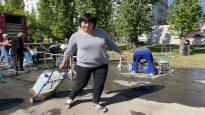82-year-old Jelena Sufray had to drag large canisters of drinking water to the fifth floor of her apartment building because the war destroyed the water supply in the big city.
MYCOLA SPECIES At the home of a mother and her adult daughter in Mykolayiv, cooking begins by first packing a water canister into a wheelbarrow and going in search of water.
The nearest water distribution point is a few blocks away. While walking there Shalejko below stops for a moment to look at the destruction of the morning’s rocket attack.
The explosion of a Russian cluster bomb has destroyed cars. No one is known to have been killed, although rockets rained down around the city.
When Shalejko gets to the tankers, luckily he doesn’t have to wait his turn. Tank trucks have been built with hoses and pipes to so many taps that more than 40 people can fill their canisters with clean drinking water at the same time.
The war is close in many ways: at the same time, across the street, bomb disposal officers are examining an unexploded ordnance.
Mykolaiv is a city almost the size of Helsinki, located near the front in the southern part of Ukraine. The wartime has been particularly difficult for the residents because in April the water pipe leading to the city was broken due to the war.
Originally, drinking water came through a pipe from the city of Kherson, which is now occupied by Russia. That’s why Ukraine can’t even fix the water pipe.
The washing machine had to be replaced with a hand washer
Shalejko fills the 30 liter canister quickly. Half a kilometer away in the backyard, he notices that the front door to the stairwell is locked, and the keys were not included.
– Mother, throw me the key, Shalejko shouts a couple of times, until mother Jelena Sufray appears at the fifth floor window and drops the key down.
This time the elevator is working, so there is no need to drag water up the stairs.
Shalejko and Sufray sit at the kitchen table and talk about Mykolayiv’s water shortage.
– In the first couple of days, when we didn’t have water, we bought water from shops, Sufray recalls.
However, it was expensive. Five liters of water cost 40 hryvnias, or well over one euro. It is felt in the pensioner’s wallet in a country where the average pension is a little over one hundred euros per month.
The stores also quickly ran out of water. After that, it was searched for in wells, which were mostly in private residential areas of the outskirts of the city. There, apartment building residents could also fill their water canisters. The city was also quickly drilled twenty new wells (you switch to another service).
– We collected water for washing dishes, flushing the toilet and washing, Shalejko says.
Shalejko points to the washing machine in the kitchen. Its water consumption is so high that it has not been possible to use it.
– That’s why we only wash the most important clothes by hand, says Shalejko.
Tank trucks from other parts of Ukraine started transporting drinking water
In May, water began to be transported by tanker trucks from Odessa and other parts of Ukraine.
– Water was brought to our yard by car, because there are elderly people here who don’t leave their homes and live alone, says Sufray.
Sufray is 82 years old himself, but he did his best for the family’s water supply.
– Even I at this age collected a couple of canisters of water and dragged them up the stairs because the elevator didn’t work, says Sufray.
Bottled water has also been brought from Odessa, which the volunteers have distributed to the townspeople.
By the middle of May, water finally started flowing in the city’s water supply network as well, but at such a low pressure that it is not enough for high places.
In Sufray and Shalejko’s home, in the apartment building on the hill, it was raining 2-3 hours a day when ‘s film crew visited the place in May. Since then, the situation has improved.
In Mariupol, which suffers from the worst water shortage, water is collected from puddles
Water supply is also in great difficulty in other areas near the front. Ukrainian authorities are building new water pipes to replace broken ones and trying to improve water quality.
The most difficult situation is in Russian-occupied Mariupol, which has been destroyed almost to the ground.
Advisor to the mayor Petro Andriushchenko has told (you switch to another service), that there is no clean drinking water in Mariupol. Residents have to collect water from, for example, puddles.
“It’s been hard, but we’ve survived”
– We still have to deal with the water problem. You can live without water for a while when everyone helps each other. However, it is impossible to survive being bombed from the sky, says Sufray.
Because of the dangers, his other children and all his grandchildren have already fled to safety abroad.
However, Sufray plans to stay at home, no matter what happens on the Mykolayiv front and even if the problems with access to clean water continue.
– It has been hard, but we have survived, says Sufray.
